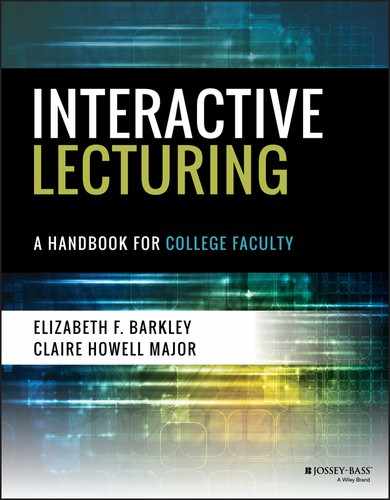ENGAGING LECTURE TIP 22
Slide Replacements
Slide decks, whether created through PowerPoint, Keynote, Prezi, or other programs, seem to be the default mode for any kind of oral presentation, including lectures. Students seem to expect slide presentations as well. We know that visuals can enhance listeners' experience and understanding, and that knowledge coupled with student expectations can often prompt us to choose to create a slide deck, whether we really want to or not. The downside of this new default, however, is that many people have grown weary of slide decks, particularly if the slide-based talks aren't done extremely well.
There are alternatives to slide decks, however, that still allow for creating visually engaging lectures. Using Slide Replacements means choosing a different form of visual support for a lecture that takes the place of a slide deck. Using Slide Replacements in lectures has several advantages. It allows for a form of presentation that students will not expect, and the surprise can be refreshing for them. Students can have a tendency to tune out during slide presentations, so choosing a different format can be motivating for them. Using Slide Replacements gives you more flexibility in developing your own form because you won't have a default setting making decisions for you. Indeed, you can even go without slides, as our colleague Jose Bowen advocates (2012).
Consider using the following Slide Replacements:
Props Most of us spend considerable time in front of a screen, whether it is a smartphone, computer, or television. Props offer students something physical to look at. Whether you hold up a model of something, a book, an audiotape, or other, using props during a lecture can have some advantages. Props can break up monotony of an oral-only essay. Props can energize and entertain. They enable students to focus on a concrete rather than an abstract concept. You can even pass around some props, so students get to hold the object, which is appealing to yet another of their senses.
Video A good video has a vibrancy that static slides lack. It typically has movement and sound and perhaps music and dialog. Video can help you create the right emotional atmosphere to begin or end a lecture or alternately to illustrate a specific point. If you do choose to use video, make sure it is really compelling and try to keep it short, or students will feel like you are simply using it as a substitute for teaching and are thereby shirking your professional responsibilities.
Flip Chart The advantage to flip charts is that you create the visuals you need in the moment that you need them with the students right there with you. The act of creating something during the moment can help draw students into the activity and the talk in ways that a slide might not. Even if you prewrite the content, flip charts can give the feeling of a real and in-the-moment experience. Unlike slide decks, you can add to flip charts easily during a presentation.
Signs Instead of using slides, you could choose to hold up physical slides or signs with a word, phrase, or picture on it, and flip them in sync with your talk. Signs can hold students' attention by illustrating key points as you flip through along with your lecture. (Think of Bob Dylan in “Subterranean Homesick Blues.”).
The Board Many college instructors make effective use of a chalkboard or whiteboard. You can write short words or phrases on the board to supplement your ideas, just as you would display in a slide. The challenge is that the board can be misused, a situation that can be avoided by taking several steps. For example, make sure all students have an unobstructed view of the board. Ensure that you do not keep your back turned to the students for long. Don't try to write out more than a word or very brief phrase—it will pull you away from students and to the board (see Tip 43: Weatherperson). Make sure that your handwriting is legible and that you are spelling the words correctly. You might also consider designating part of the board to information that will remain for the whole lecture and part that you can erase and change as you go along. Whiteboards and interactive screens can combine attributes of slides and the traditional blackboard.
Example
Key References and Resources
- Berkun, S. (2013). How to present well without slides [Web log post]. Retrieved August 31, 2016, from http://scottberkun.com/2013/how-to-present-well-without-slides/
- Bowen, J. A. (2012). Teaching naked: How moving technology out of your college classroom will improve student learning. San Francisco, CA: Jossey-Bass.
- Mayer, R. E. (2017). Principles for learning from multimedia with Richard Mayer. Retrieved from https://hilt.harvard.edu/blog/principles-multimedia-learning-richard-e-mayer
- Morgan, N. (2011). 10 things to do instead of PowerPoint. Forbes. Retrieved from www.forbes.com/sites/nickmorgan/2011/06/13/10-things-to-do-instead-of-power-point/#39f7ad182ca7
